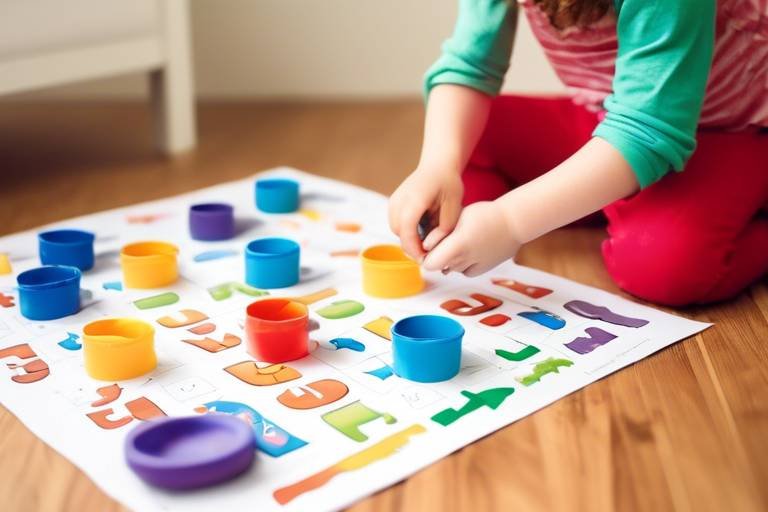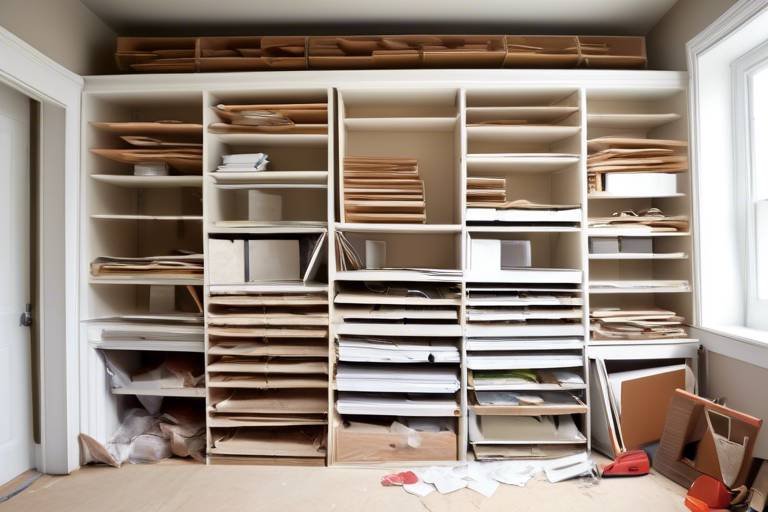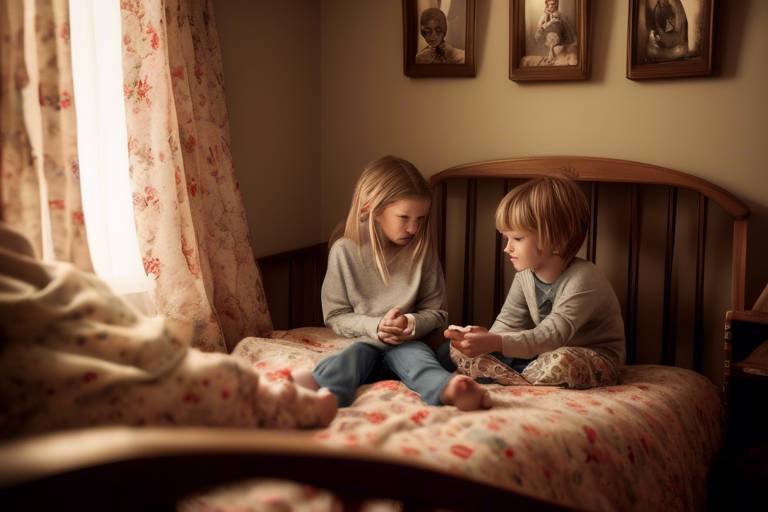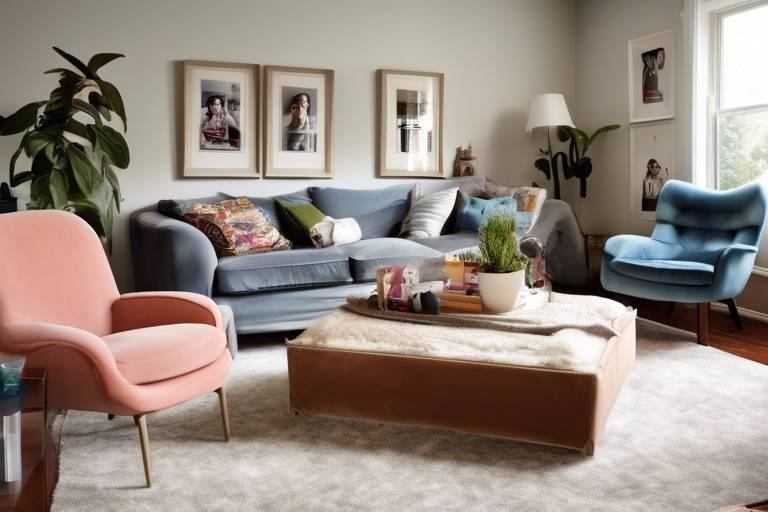Home Organization: What Works for Your Family?
When it comes to home organization, there’s no one-size-fits-all solution. Every family has its own unique rhythm, preferences, and challenges. Have you ever walked into a friend's home and thought, "Wow, how do they keep everything so tidy?" Well, the secret often lies in understanding what works for *them*—and that could be entirely different from what works for you. So, how do you create a functional and harmonious living space that promotes productivity and well-being for your family? Let’s dive into some effective strategies tailored to your family's specific needs.
First things first, it’s essential to recognize that every family is unique. Your family dynamics, lifestyle, and daily routines play a significant role in how you should organize your home. For instance, families with young children may need to prioritize safety and accessibility, while families with teenagers might focus on creating personal spaces that reflect their evolving identities. Understanding these nuances is crucial for developing a personalized organization plan that truly resonates with your family's lifestyle.
Think about your daily routines. Do you often find yourselves scrambling to find keys, school papers, or that elusive remote control? These common frustrations can be alleviated with a little foresight and planning. For example, if your family is always on the go, creating a designated drop zone near the entrance for shoes, bags, and keys can save precious time. By assessing your family's habits and preferences, you can identify the areas that need the most attention and tailor your organization strategies accordingly.
Another essential aspect to consider is the emotional connection your family has with certain items. Are there sentimental objects that spark joy and memories? Or are there items that are simply taking up space? Engaging in a thoughtful decluttering process can help you differentiate between the two. This not only clears physical clutter but also creates a more serene environment, allowing your family to thrive.
Ultimately, the goal of home organization is to create a space that not only looks good but also enhances your family's quality of life. Imagine walking into a room that feels welcoming and functional, where everything has its place, and you can easily find what you need. Doesn’t that sound like a dream? By understanding your family's needs and preferences, you can embark on a journey to transform your home into a sanctuary that fosters connection, creativity, and calm.
- What are some quick tips for decluttering? Start small by tackling one area at a time, such as a drawer or a shelf. Use the "one in, one out" rule to maintain balance.
- How can I involve my kids in the organization process? Make it fun! Create a game out of decluttering or set up a reward system for completing tasks.
- What should I do with items I no longer need? Consider donating them to local charities, selling them online, or recycling when possible.

Understanding Your Family's Needs
Every family is unique, and understanding specific organizational needs is crucial. To create a home that truly works for you, it's essential to assess your family's lifestyle, habits, and preferences. Think of your home as a living organism; it needs to adapt and grow with its inhabitants. Start by asking yourself: What does our daily routine look like? Are we a busy family always on the go, or do we spend more time at home? Understanding these dynamics can help you develop a personalized organization plan that fits seamlessly into your family's life.
Consider conducting a family meeting where everyone can share their thoughts on what works and what doesn't in your current setup. This is a great opportunity to gather input from everyone, including the kids! You might be surprised at how much insight they can provide. By involving the entire family in the conversation, you not only foster a sense of ownership but also encourage teamwork in the decluttering and organizing process.
As you delve deeper into understanding your family's needs, think about the following aspects:
- Daily Routines: What activities do you engage in regularly? Are there specific times when certain spaces become cluttered?
- Storage Needs: Do you have hobbies or interests that require specific storage solutions? For example, a family of artists might need a dedicated space for supplies.
- Future Goals: Are you planning to expand your family or introduce new activities? Anticipating these changes can help you create a more adaptable organization system.
Additionally, consider the emotional aspect of your belongings. Every item in your home tells a story, and it’s important to recognize the sentimental value some things hold. However, it’s equally important to differentiate between items that spark joy and those that simply take up space. By being mindful of this balance, you can declutter effectively while still honoring your family’s memories.
In essence, understanding your family's needs is not just about tidying up; it's about creating a harmonious living environment that fosters productivity and well-being. By taking the time to assess your family's lifestyle and preferences, you can develop an organization plan that not only meets your current needs but also adapts to future changes. This thoughtful approach will lead to a more functional and enjoyable home for everyone.

Decluttering Strategies
Decluttering is not just about tossing things out; it's a transformative process that can breathe new life into your home. Imagine walking into a space that feels open and inviting rather than cramped and chaotic. The journey to a clutter-free home begins with understanding that less is often more. You might be surprised to find how much weight is lifted off your shoulders when you let go of items that no longer serve you or your family. So, where do you start?
First, it's essential to approach decluttering with a plan. Think of it as a treasure hunt where you’re not just looking for items to keep but also for those to part with. Start by assessing the areas in your home that cause the most stress. Is it the overflowing closet, the crowded kitchen counter, or perhaps the chaotic playroom? Identifying these hotspots will help you focus your efforts where they matter most.
One effective strategy is the room-by-room approach. By tackling one room at a time, you can avoid feeling overwhelmed. Set aside a specific time each week to focus on a different area. For instance, dedicate one Saturday to the living room, and the next to the kitchen. This systematic method ensures that no corner is left untouched. As you go through each room, ask yourself the following questions:
- When was the last time I used this item?
- Does this item bring me joy?
- Is it worth the space it occupies?
These questions can serve as a guide to help you make those tough decisions. Remember, it’s about creating a space that reflects your family's lifestyle and values.
Let’s delve deeper into this room-by-room strategy. It’s like peeling an onion; you take it layer by layer. For example, when decluttering your living room, start with the coffee table. Clear it off completely and only put back items that you use regularly or absolutely love. Move on to the shelves, removing books or decor that no longer resonates with you. You might even find that family photos or art pieces that hold sentimental value are the only things worth keeping. This method not only clears physical space but also allows you to appreciate what truly matters.
Next, consider the kitchen. This space can quickly become a dumping ground for miscellaneous items. Take everything out of your cabinets and drawers, and only return what you actually use. You might be surprised to find expired spices or gadgets that have never seen the light of day. By creating designated zones for cooking utensils, baking supplies, and food storage, you’ll streamline your kitchen workflow, making meal prep a breeze.
Decluttering doesn’t have to be a solo mission. In fact, involving your family can make the process more enjoyable and effective. Turn it into a fun weekend project! You could even make a game out of it—whoever declutters the most gets to choose the next family movie night! This not only teaches kids about the importance of organization but also fosters teamwork and communication. Plus, when everyone contributes, it’s easier to maintain the clutter-free environment you’ve worked so hard to create.
To keep the momentum going, establish a “one in, one out” rule. For every new item brought into the home, encourage family members to let go of an old one. This simple practice can significantly reduce clutter over time and instill a sense of mindfulness about possessions.
Q: How often should I declutter my home?
A: It's beneficial to declutter at least twice a year, but you can do it more frequently if you notice areas becoming cluttered again.
Q: What do I do with items I want to get rid of?
A: Consider donating, recycling, or selling items. Many local charities will gladly accept gently used items, and online marketplaces can help you sell things you no longer need.
Q: How can I maintain a clutter-free home?
A: Establish daily habits, such as tidying up for 10 minutes each day and involving the whole family in keeping spaces organized.

Room-by-Room Decluttering
When it comes to decluttering your home, tackling each room individually can be a game changer. Think of it like eating a giant pizza; you wouldn't try to swallow it whole, right? Instead, you take it one slice at a time. This method not only makes the task less overwhelming but also allows you to focus on specific areas, ensuring nothing is overlooked. Start with the room that feels the most chaotic or the one you use the most—often, this is the living room or kitchen. By breaking down the decluttering process, you can create a more organized and functional space that reflects your family's needs.
Begin in the living room, where the family gathers for relaxation and entertainment. Start by removing items that don’t belong, like stray toys or misplaced shoes. Next, assess your furniture arrangement—does it facilitate conversation and comfort? Consider utilizing multifunctional furniture, such as ottomans with storage inside, to maximize space. You can also create designated areas for different activities, like a reading nook or a game zone, to keep things organized.
Next, move to the kitchen, which often becomes a catch-all for various items. Empty out your cabinets and drawers, and ask yourself, “Do I really need this?” If an item hasn’t been used in the past year, it’s time to let it go. Organizing your kitchen is all about efficiency. Use clear containers for pantry items to quickly see what you have, and label everything to make it easy for family members to find what they need. Remember, a well-organized kitchen not only looks good but also streamlines meal prep, making cooking a breeze.
Don’t forget about the bedrooms! Start by tackling the closet—this is often where clutter accumulates the most. Hang seasonal clothes together and donate anything that doesn’t fit or hasn’t been worn in ages. Use under-bed storage for shoes or out-of-season clothing to free up space. For kids’ rooms, involve them in the process. Teach them the importance of keeping their space tidy by making it a fun challenge. Perhaps set a timer and see who can declutter the fastest!
Lastly, tackle the bathroom. Go through your toiletries and dispose of any expired products. Use drawer dividers to keep items organized and easily accessible. Consider a caddy for frequently used items to keep your counters clear. Remember, decluttering is not just about throwing things away; it's about creating a space that feels good and functions well for your family.
In summary, a room-by-room approach to decluttering allows you to focus your energy and make significant changes without feeling overwhelmed. By following these steps, you'll create a harmonious living space that promotes productivity and well-being for everyone in the family.
- How often should I declutter my home? It's a good idea to reassess your space every few months, especially after holidays or significant life changes.
- What should I do with items I don’t want anymore? Consider donating, recycling, or selling items to give them a second life.
- Can decluttering really improve my family's mood? Yes! A tidy environment can reduce stress and create a more peaceful atmosphere.

Living Room Organization
The living room is often considered the heart of the home, a space where families gather to relax, entertain, and create lasting memories. But with the hustle and bustle of daily life, it can quickly become a catch-all for clutter. To transform your living room into a serene oasis that reflects your family's style and meets your functional needs, it's essential to implement effective organization strategies. So, how do you begin this transformation?
First, start by assessing the current state of your living room. Take a moment to observe what items are taking up space and whether they truly belong in this communal area. This could include anything from toys and magazines to decorative items that no longer resonate with you. Consider creating a vision board for your ideal living space, which can serve as a guiding light during your organization journey. Visualize a room that feels open, inviting, and tailored to your family's lifestyle.
Next, embrace the power of multifunctional furniture. In a living room, every piece of furniture should serve a purpose. For instance, a stylish coffee table with hidden storage can double as a place to stash blankets or board games. Similarly, consider using ottomans that can be both seating and storage. This not only keeps your space tidy but also adds an element of surprise and functionality.
Another effective strategy is to create designated zones within your living room. By dividing the space into functional areas, you can establish a more organized environment. For example, you might have a reading nook with a comfortable chair and a small bookshelf, a play area for children, and a media zone for entertainment. This zoning approach not only makes the room more organized but also encourages family members to return items to their designated spots.
To further enhance the organization, consider implementing a system for managing items that tend to accumulate in the living room. This could be as simple as a stylish basket or bin for remote controls, magazines, and other small items that usually clutter surfaces. By providing a specific home for these items, you can significantly reduce visual clutter.
Lastly, don't forget the importance of regular maintenance. Just like a garden needs tending, your living room will require periodic check-ins to ensure it stays organized. Set aside time each week to reassess the space, remove any items that have crept in, and reestablish order. This will not only keep your living room looking its best but also instill a sense of pride and ownership within your family.
In summary, organizing your living room is about creating a space that is not only functional but also reflects your family's personality. By assessing your current situation, embracing multifunctional furniture, creating designated zones, managing small items effectively, and committing to regular maintenance, you can transform your living room into a welcoming and organized haven for your family.
- How often should I reorganize my living room? Regular check-ins, ideally weekly, can help maintain organization.
- What are some budget-friendly storage solutions? Consider using decorative baskets or repurposing furniture with hidden storage.
- How can I involve my family in the organization process? Make it a fun activity by assigning tasks and allowing everyone to suggest ideas.

Kitchen Efficiency
When it comes to the kitchen, efficiency is the name of the game. This space is not just where meals are prepared; it's the bustling hub of family life, where memories are made over shared dinners and laughter. To create a kitchen that works for you, it’s essential to implement some smart organization strategies that can save you time and make cooking a more enjoyable experience. Have you ever found yourself rummaging through cluttered drawers or searching for that elusive spice jar? Let’s dive into some innovative ideas that can transform your kitchen into a well-oiled machine.
First off, consider the layout of your kitchen. A well-thought-out design can significantly enhance your efficiency. For instance, the work triangle concept—where the stove, sink, and refrigerator form a triangle—ensures that you’re not wasting steps while cooking. If your kitchen allows, try to arrange these three key areas within easy reach of one another. This will not only make cooking faster but also safer, as you’ll be less likely to trip over things while multitasking.
Next, let’s talk about storage solutions. A clutter-free countertop is vital for maintaining efficiency in the kitchen. Utilize vertical space by installing shelves or hanging racks for pots and pans. You can even use magnetic strips to hold knives or metal utensils, freeing up drawer space for other items. Drawer dividers are another fantastic way to keep utensils organized. Instead of tossing everything into one drawer, categorize items—spatulas, whisks, and measuring cups can each have their own designated space.
Additionally, consider your pantry organization. A well-organized pantry can save you time and money. Group similar items together, such as canned goods, snacks, and baking supplies. Use clear containers to store dry ingredients like flour and sugar; this not only keeps them fresh but also allows you to see what you have at a glance. Labeling these containers can further streamline your cooking process, making it easy to find what you need without digging through stacks of boxes.
Finally, don’t underestimate the power of a meal prep station. Dedicate a specific area of your kitchen for meal preparation. This could be as simple as a cutting board and knife set, or you might want to include a small appliance like a food processor. Having a designated space for prepping ingredients can make the cooking process smoother and more enjoyable. Plus, it encourages you to cook more often, which is always a win for the family!
In summary, kitchen efficiency is all about making small changes that lead to big results. By optimizing your layout, utilizing smart storage solutions, and creating a meal prep station, you’ll transform your kitchen into a functional and inviting space. Remember, the goal is to create an environment that not only enhances productivity but also fosters family connections through the joy of cooking together.
- How can I maintain kitchen organization? Regularly declutter your kitchen and reassess your storage solutions to ensure everything has its place.
- What are some quick tips for meal prep? Plan your meals for the week, chop vegetables in advance, and batch cook to save time during busy days.
- How do I choose the right storage containers? Opt for clear, stackable containers that are airtight to keep your food fresh and visible.

Involving the Whole Family
When it comes to home organization, involving the whole family is not just beneficial; it’s essential! Think about it: a house is more than just a collection of rooms; it’s a living, breathing entity where every family member contributes to the energy and vibe. So, why not make the organization process a family affair? By getting everyone on board, you not only lighten your load but also instill a sense of responsibility and ownership in your kids and partner. Plus, it can be a fun bonding experience!
Start by having an open discussion with your family about the current state of your home. Ask questions like, “What areas do we struggle with the most?” or “How can we make our space more enjoyable?” This kind of dialogue not only helps you pinpoint the clutter hotspots but also encourages everyone to express their opinions and ideas. You might be surprised by the insights your children have! They often have creative solutions that adults might overlook.
Once you've identified the clutter zones, assign tasks based on each family member’s strengths and preferences. For instance, if your teenager loves to organize their room, let them take the lead there. You could say, “Hey, why don’t you tackle your closet this weekend?” Meanwhile, younger kids can help with simpler tasks like sorting toys or books. This way, everyone feels involved, and the work doesn’t feel overwhelming.
To keep everyone motivated, consider creating a family organization chart. This could be a fun visual representation of who is responsible for what. You could use a whiteboard or a digital app to track progress and celebrate achievements. For example, when someone completes a task, they can check it off, and you can reward the family with a treat or a fun outing. This not only makes the process engaging but also builds a sense of teamwork.
Moreover, make it a regular activity! Set aside a specific day each month for family decluttering sessions. This could be a Saturday morning ritual where you all come together with some snacks, music, and enthusiasm. You could even turn it into a game—who can find the most items to donate? This approach transforms what could be a tedious chore into an exciting event.
Finally, remember to celebrate your successes together. After a big decluttering session, take a moment to admire your hard work. You might create a “before and after” photo album to document the transformation of each space. This not only reinforces the idea that organization is a continuous journey but also encourages everyone to maintain the newfound order. After all, a tidy home is a happy home, and when everyone pitches in, it becomes a joyful sanctuary for the entire family!
- How can I get my children to help with organization? Start by involving them in the conversation about why organization is important. Make it fun, and assign age-appropriate tasks.
- What if my partner is resistant to organizing? Approach the topic gently. Discuss the benefits of a tidy space and how it can improve daily life. Offer to work together to make it a joint effort.
- How often should we declutter as a family? Aim for a family decluttering day once a month, but feel free to do mini-sessions whenever clutter builds up!

Creating Functional Spaces
When it comes to home organization, creating functional spaces is essential for enhancing your family's daily life. Think of your home as a well-oiled machine; every part needs to work in harmony for it to function smoothly. By designing areas that serve specific purposes, you can streamline daily tasks and make life easier for everyone. Imagine walking into a room where everything has its place, and you can find what you need without rummaging through piles of clutter. Sounds dreamy, right? Well, it’s absolutely achievable!
To kick things off, consider the idea of a family command center. This is more than just a fancy term; it’s a centralized hub where your family can keep track of schedules, important documents, and daily reminders. Think of it as the nerve center of your home. You can set it up in a corner of your kitchen or a designated wall space in your hallway. The key is to make it easily accessible for everyone. A simple setup might include:
- A calendar for tracking events and appointments
- File holders for important documents
- A whiteboard for jotting down reminders or grocery lists
- A corkboard for displaying kids' artwork or important notices
Next up, let’s talk about storage solutions, especially if you’re dealing with limited space. Small homes can feel cramped, but with a little creativity, you can maximize every nook and cranny. Consider multi-functional furniture, like a storage ottoman or a bed with drawers underneath. These pieces not only save space but also add to your home’s aesthetic. Here are some ideas to get you started:
- Vertical storage: Use shelves that go up instead of out. This draws the eye upward and frees up floor space.
- Under-stair storage: If you have stairs, you can utilize that space for built-in shelves or cabinets.
- Hooks and racks: Don’t underestimate the power of hooks for hanging bags, hats, or even pots and pans in the kitchen.
Another great idea is to create a designated play area for kids. This not only keeps their toys organized but also helps them learn responsibility. By having a specific spot for play, you can teach your children to put things back where they belong. Use colorful bins or baskets to make it fun and engaging for them. You might be surprised at how much they enjoy tidying up when they have a place for everything!
Lastly, let’s not forget about the importance of flexibility. Your family’s needs may change over time, and so should your spaces. Regularly assess how each area is functioning. Is the command center still working for your family? Do the storage solutions need an upgrade? By staying adaptable, you can ensure your home remains a sanctuary of organization and efficiency.
Q: How often should I reorganize my functional spaces?
A: It’s a good idea to reassess your spaces at least twice a year. This allows you to adapt to any changes in your family's routines or needs.
Q: What are some quick tips for maintaining an organized home?
A: Establish daily habits such as a quick tidy-up before bed, involving the whole family in cleaning routines, and regularly decluttering to keep your spaces functional.
Q: How can I encourage my kids to keep their spaces organized?
A: Make it fun! Use colorful storage bins, set up a reward system, and involve them in the organization process to foster a sense of ownership.

Designing a Family Command Center
In today's fast-paced world, keeping track of family schedules, important documents, and daily reminders can feel like trying to juggle flaming torches. That's where a Family Command Center comes into play! Imagine it as the control tower of your home—a centralized hub that keeps everything organized and accessible. Designing this space not only enhances your family's productivity but also reduces stress, making daily life smoother and more enjoyable.
To start, think about where in your home would be the most effective location for your command center. A corner of the kitchen, a section of the hallway, or even a dedicated room can serve as a great spot. The key is to choose a place that everyone can easily access and that allows for frequent interaction. Once you've picked a location, it's time to consider what elements to include. Here are some essentials that can transform your command center into a powerhouse of organization:
- Calendar: A large wall calendar or a digital one can help everyone stay on the same page regarding appointments, events, and important dates.
- Bulletin Board: This is perfect for displaying reminders, school schedules, and inspirational quotes. It adds a personal touch and keeps important information visible.
- File Organizer: A dedicated space for important documents—like medical records, school papers, and bills—will keep everything in one place, reducing the time spent searching for crucial items.
- To-Do Lists: Whether digital or on paper, having a visible list of tasks can help everyone stay accountable and on track.
Now, let’s talk about aesthetics! A well-designed command center should not only be functional but also visually appealing. Use colors and decor that reflect your family's personality. Consider adding a few decorative elements like plants or family photos to make the space inviting. Remember, the goal is to create a space that feels warm and welcoming, encouraging family members to use it regularly.
Another aspect to consider is how to involve everyone in maintaining the command center. Set aside some time each week for a family meeting to update the calendar, review tasks, and discuss upcoming events. This not only keeps everyone informed but also fosters a sense of teamwork and responsibility. Plus, it’s a great way to bond as a family!
Lastly, don't forget to periodically reassess the effectiveness of your command center. As your family's needs change, so should your organization strategies. Be flexible and willing to adapt your system, whether it means adding new elements, removing outdated ones, or even redesigning the space entirely. Remember, the ultimate goal is to create a functional and harmonious environment that promotes productivity and well-being for your family.
1. What should I include in my family command center?
A family command center typically includes a calendar, bulletin board, file organizer, and to-do lists. Personalize it with decor that reflects your family’s style!
2. How can I get my family involved in maintaining the command center?
Schedule regular family meetings to update the calendar and tasks. Encourage everyone to contribute and make it a fun, collaborative experience.
3. Where is the best place to set up a command center?
Choose a location that is easily accessible to everyone, such as a corner of the kitchen or a hallway. The key is to ensure it's a spot that encourages regular use.
4. How often should I update the command center?
Regularly assess your command center’s effectiveness. Weekly updates during family meetings can help keep everything current and organized.

Storage Solutions for Small Spaces
Living in a small space can feel like a constant battle against clutter. However, with the right storage solutions, you can transform even the tiniest areas into functional and organized havens. The key is to think creatively and utilize every nook and cranny effectively. For instance, consider using vertical space to your advantage. Installing shelves high on the walls can free up floor space while providing ample storage for books, decorative items, or even kitchen supplies.
Another brilliant idea is to invest in multi-functional furniture. Pieces like ottomans that double as storage bins or beds with drawers underneath can make a significant difference. Imagine a cozy living room where your coffee table not only holds your magazines but also stores board games and blankets. This not only keeps your space tidy but also adds an element of surprise when guests discover hidden compartments.
Don't forget about the power of under-bed storage. This often-overlooked area can be a treasure trove for seasonal clothing, shoes, or even extra bedding. Using clear bins allows you to see what's inside without having to dig through everything, making it easier to stay organized. Additionally, consider using vacuum-sealed bags for items that you don’t need immediate access to; they save space and keep everything dust-free.
For those who are really tight on space, wall-mounted organizers can be a game changer. These can come in various forms, such as pegboards, hooks, or magnetic strips, allowing you to hang everything from kitchen utensils to craft supplies. This not only keeps things off the counter but also adds a touch of personality to your decor. Imagine walking into your kitchen and seeing a beautifully organized wall of pots and pans, all easily accessible and visually appealing.
To illustrate these ideas further, here’s a simple table summarizing some effective storage solutions:
| Storage Solution | Description | Benefits |
|---|---|---|
| Vertical Shelving | Utilizing wall space with tall shelves. | Maximizes storage without taking up floor space. |
| Multi-functional Furniture | Furniture that serves more than one purpose. | Increases functionality while saving space. |
| Under-bed Storage | Using the space beneath your bed for storage. | Great for storing seasonal items or out-of-season clothing. |
| Wall-mounted Organizers | Using hooks, pegboards, or shelves mounted on the wall. | Keeps items off surfaces and adds visual interest. |
Lastly, remember that organization is not just about putting things away; it's about creating a system that works for you and your family. Regularly reassess your storage solutions and adjust them as your needs change. By implementing these creative storage ideas, you can make your small space feel larger, more organized, and ultimately more enjoyable to live in.
- What are some quick tips for decluttering a small space?
Start small by focusing on one area at a time, such as a drawer or a shelf. Use the “one in, one out” rule to keep clutter at bay. - How can I maximize closet space?
Use slim hangers, add shelves, and consider vertical storage solutions like hanging organizers or hooks. - What should I do with items I no longer need?
Donate, sell, or recycle items that you no longer use or need, ensuring they find a new home rather than just taking up space.
Frequently Asked Questions
- What are the first steps to organizing my home?
Start by assessing your family's needs and lifestyle. Identify the areas that require the most attention and create a list of priorities. Decluttering is the first step—eliminate items that no longer serve a purpose. This will help you create a more spacious and organized environment.
- How can I involve my family in the organization process?
Getting everyone on board can be a game changer! Make it a fun family project by assigning tasks based on each member's strengths. For example, kids can help with sorting toys while adults tackle the kitchen. Celebrate small victories together to keep the momentum going!
- What are some effective decluttering strategies?
One popular method is the room-by-room approach. Focus on one room at a time, starting with the most cluttered. Use the four-box method—keep, donate, throw away, and relocate—to simplify decision-making. This method ensures you don't get overwhelmed and helps maintain focus.
- How can I organize my kitchen for better efficiency?
Consider using vertical space by adding shelves or hanging racks. Group similar items together, like pots and pans or baking supplies, to streamline your cooking process. Also, utilize clear containers for easy visibility and quick access to ingredients.
- What is a family command center, and how do I create one?
A family command center is a designated space where schedules, important documents, and reminders are kept. To create one, choose a central location in your home, like a hallway or kitchen wall. Use a bulletin board, calendar, and storage bins to keep everything organized and accessible for everyone.
- How can I maximize storage in small spaces?
Think outside the box! Use multifunctional furniture, like ottomans with storage or beds with drawers. Wall-mounted shelves can also save floor space. Don't forget to use under-bed storage and utilize vertical storage solutions, such as hooks and pegboards, to keep items off surfaces.
- How often should I declutter my home?
It's a good idea to declutter at least twice a year, but you can do it more frequently if needed. Regularly assess your belongings and make it a habit to discard or donate items that are no longer useful. This keeps clutter at bay and maintains a harmonious living space.



















